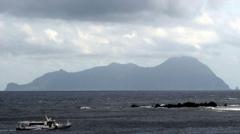More than 900 earthquakes have rattled the Tokara Islands, located in southern Japan, over the past fortnight, creating an atmosphere of unease among the local population. The seismic activity intensified beginning on June 21, peaking with a magnitude 5.5 quake on Wednesday, prompting authorities to keep residents on high alert. While there has been no reported damage or tsunami threats, residents are advised to prepare for possible evacuations.
"It's terrifying to think about falling asleep," voiced a local resident to regional broadcaster MBC, expressing widespread anxiety about the continuous quaking. The Tokara chain, home to only around 700 people across seven of its twelve islands, has historically experienced earthquake clusters, yet the current wave of tremors is unprecedented in frequency, as noted by local media.
Japan ranks among the world's most seismically active regions due to its positioning along the Pacific Ring of Fire, where multiple tectonic plates converge, leading to around 1,500 earthquakes annually. Many residents have reported feeling as though the ground is perpetually shaking due to the sheer volume of recent tremors. Chizuko Arikawa, a farmer from Akusekijima Island, described eerie pre-quake noises, and voiced concerns for the mental well-being of the community, stating, "Everyone's exhausted. We just want it to stop."
Local authorities have requested that media refrain from overwhelming the islanders with inquiries, citing the toll that constant questioning has taken on residents' mental health. Some guesthouses have halted tourist bookings to potentially serve as makeshift shelters for locals.
Amidst this turmoil, an ongoing rumor fueled by a 1999 comic that predicted a significant earthquake on July 5 has added a layer of anxiety, contributing to a wave of cancellations from previously planned visits. While most quakes in Japan are minor, there remains a societal apprehension regarding the long-feared "big one"—a catastrophic event that could result in vast casualties.
In response to this latest series of quakes, government officials are stepping up efforts to fortify public preparedness, advocating for the construction of embankments and evacuation buildings to enhance response measures. They recognize that substantial efforts are essential to brace the population for potential disasters.
"It's terrifying to think about falling asleep," voiced a local resident to regional broadcaster MBC, expressing widespread anxiety about the continuous quaking. The Tokara chain, home to only around 700 people across seven of its twelve islands, has historically experienced earthquake clusters, yet the current wave of tremors is unprecedented in frequency, as noted by local media.
Japan ranks among the world's most seismically active regions due to its positioning along the Pacific Ring of Fire, where multiple tectonic plates converge, leading to around 1,500 earthquakes annually. Many residents have reported feeling as though the ground is perpetually shaking due to the sheer volume of recent tremors. Chizuko Arikawa, a farmer from Akusekijima Island, described eerie pre-quake noises, and voiced concerns for the mental well-being of the community, stating, "Everyone's exhausted. We just want it to stop."
Local authorities have requested that media refrain from overwhelming the islanders with inquiries, citing the toll that constant questioning has taken on residents' mental health. Some guesthouses have halted tourist bookings to potentially serve as makeshift shelters for locals.
Amidst this turmoil, an ongoing rumor fueled by a 1999 comic that predicted a significant earthquake on July 5 has added a layer of anxiety, contributing to a wave of cancellations from previously planned visits. While most quakes in Japan are minor, there remains a societal apprehension regarding the long-feared "big one"—a catastrophic event that could result in vast casualties.
In response to this latest series of quakes, government officials are stepping up efforts to fortify public preparedness, advocating for the construction of embankments and evacuation buildings to enhance response measures. They recognize that substantial efforts are essential to brace the population for potential disasters.


















